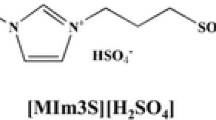Bulk solid-state polyantimonic-acid-(PAA)-based proton-conducting membranes were manufactured via cold isostatic pressing using an inert polymeric binder. Precursor PAA powder was obtained using stepwise aqueous hydrolysis of antimony pentachloride. X-ray diffraction (XRD) data showed that hydrolysis resulted in crystalline PAA with the pyrochlore structure. The composition of the powder obtained via solid-state synthesis corresponded to sodium antimonate having the ilmenite structure. The logarithm of the conductivity of PAA membranes in air was linearly dependent on inverse temperature in the range 293 – 452 K. Based on XRD and conductivity data, the obtained solid-state PAA-based membranes were prospective proton conductors having a conductivity of 10–4 S/m and an activation energy of conductivity of 0.395 eV.





Similar content being viewed by others
References
L. Carrette, K. A. Friedrich, and U. Stimming, “Fuel cells: Principles, types, fuels, and applications,” ChemPhysChem, 1(4), 162 – 193 (2000).
A. Vourros, V. Kyriako, I. Garagounis, et al., “Chemical reactors with high temperature proton conductors as a main component: progress in the past decade,” Solid State Ionics, 306, 76 – 81 (2017).
M. Nomnqa, D. Ikhu-Omoregbe, A. Rabiu, et al., “Performance evaluation of a HT-PEM fuel cell micro-cogeneration system for domestic application,” Energy Syst., 10(1), 185 – 210 (2019).
S. J. Peighambardoust, S. Rowshanzamir, and M. Amjadi, “Review of the proton exchange membranes for fuel cell applications,” Int. J. Hydrogen Energy, 35(17), 9349 – 9384 (2010).
A. A. Lysova and A. B. Yaroslavtsev, “New proton-conducting membranes based on phosphorylated polybenzimidazole and silica,” Inorg. Mater., 55(5), 470 – 476 (2019).
P. Colomban, “Proton conductors and their applications: A tentative historical overview of the early researches,” Solid State Ionics, 334, 125 – 144 (2019).
N. Mahato, A. Banerjee, A. Gupta, et al., “Progress in material selection for solid oxide fuel cell technology: A review,” Prog. Mater. Sci., 72, 141 – 337 (2015).
A. B. Yaroslavtsev, Yu. A. Dobrovolsky. N. S. Shaglaeva, et al., “Nanostructured materials for low-temperature fuel cells,” Russ. Chem. Rev., 81(3), 191 – 220 (2012).
J. Yu, M. Pan, and R. Yuan, “Nafion/silicon oxide composite membrane for high temperature proton exchange membrane fuel cell,” J. Wuhan Univ. Technol., Mater. Sci. Ed., 22(3), 478 – 481 (2007).
J. P. Critchley, G. J. Knight, and W. W. Wright, “Fluorine-containing polymers” in: Heat-Resistant Polymers, Springer Science+ Business Media, New York, US, 1983, Chap. 3, pp. 87 – 123.
N. Anantharamulu, K. Koteswara Rao, G. Rambabu, et al., “A wide-ranging review on Nasicon type materials,” J. Mater. Sci., 46(9), 2821 – 2837 (2011).
D. Y. Voropaeva, M. A. Moshareva, A. B. Il’in, et al., “Phase transitions and proton conductivity in hafnium hydrogen phosphate with the NASICON structure,” Mendeleev Commun., 26(2), 152 – 153 (2016).
K. T. Adjemian, S. J. Lee, S. Srinivasan, et al., “Silicon oxide Nafion composite membranes for proton-exchange membrane fuel cell operation at 80 – 140°C,” J. Electrochem. Soc., 149(3), A256 (2002).
A. A. Gaydamaka, V. G. Ponomareva, and I. N. Bagryantseva, “Phase composition, thermal and transport properties of the system based on the mono- and dihydrogen phosphates of rubidium,” Solid State Ionics, 329, 124 – 130 (2019).
V. G. Ponomareva and G. V. Lavrova, “Effect of the excess protons on the electrotansport, structural and thermodynamic properties of CsH2PO4,” Solid State Ionics, 304, 90 – 95 (2017).
L. Mathur, I.-H. Kim, and A. Bhardwaj, “Structural and electrical properties of novel phosphate based composite electrolyte for low-temperature fuel cells,” Composites, Part B, 202, 108405 (2020).
N. L. R. M. Rashid, A. A. Samat, A. A. Jais, et al., “Review on zirconate-cerate-based electrolytes for proton-conducting solid oxide fuel cell,” Ceram. Int., 45(6), 6605 – 6615 (2019).
A. Dixit, S. B. Majumder, P. S. Dobala, et al., “Phase transition studies of sol-gel deposited barium zirconate titanate thin films,” Thin Solid Films, 447/448, 284 – 288 (2004).
F. G. Will and S. P. Mitoff, “Primary sodium batteries with beta-alumina solid electrolyte,” J. Electrochem. Soc., 122(4), 457 – 461 (1975).
F. A. Yaroshenko and V. A. Burmistrov, “Dielectric relaxation and protonic conductivity of polyantimonic crystalline acid at low temperatures,” Russ. J. Electrochem., 51(5), 391 – 396 (2015).
F. A. Yaroshenko and V. A. Burmistrov, “Proton conductivity of polyantimonic acid studied by impedance spectroscopy in the temperature range 370–480 K,” Inorg. Mater., 51(8), 783 – 787 (2015).
R. Leysen and H. Vandenborre, “Synthesis and characterization of polyantimonic acid membranes,” Mater. Res. Bull., 15(4), 437 – 450 (1980).
F. A. Belinskaya and E. A. Militsina, “Inorganic ion-exchange materials based on insoluble antimony(V) compounds,” Russ. Chem. Rev., 49(10), 933 – 952 (1980).
L. Y. Kovalenko, V. A. Burmistrov, and Y. A. Lupitskaya, “Ion exchange of H+/Na+ in polyantimonic acid, doped with vanadium ions,” Pure Appl. Chem., No. 3, 505 – 514 (2020).
F. A. Yaroshenko and V. A. Burmistrov, “Dielectric losses and proton conductivity of polyantimonic acid membranes,” Russ. J. Electrochem., 52(7), 690 – 693 (2016).
The work was supported by Grant No. 075-15-2021-370 from the President of the Russian Federation for State Support of Young Russian Scientists and Candidates of Science.
Author information
Authors and Affiliations
Corresponding author
Additional information
Translated from Novye Ogneupory, No. 2, pp. 45 – 50, January, 2022.
Rights and permissions
Springer Nature or its licensor (e.g. a society or other partner) holds exclusive rights to this article under a publishing agreement with the author(s) or other rightsholder(s); author self-archiving of the accepted manuscript version of this article is solely governed by the terms of such publishing agreement and applicable law.
About this article
Cite this article
Kurapova, O.Y., Zaripov, A.A., Pazheltsev, V.V. et al. Bulk Solid-State Polyantimonic-Acid-Based Proton-Conducting Membranes. Refract Ind Ceram 63, 90–95 (2022). https://doi.org/10.1007/s11148-022-00685-x
Received:
Published:
Issue Date:
DOI: https://doi.org/10.1007/s11148-022-00685-x




